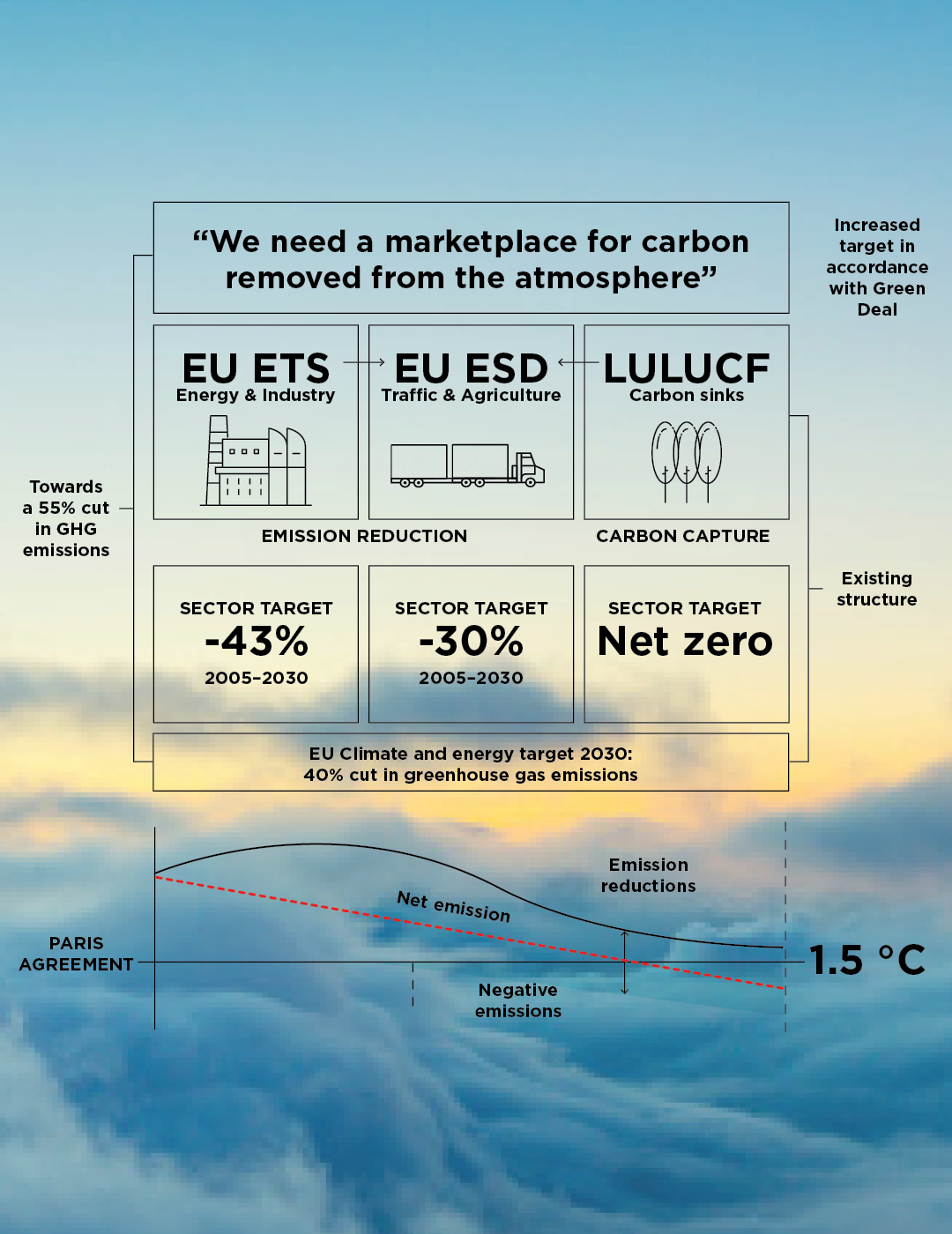At St1 we believe that we need a carbon market for sequestered and emitted CO₂. In addition to all the efforts that must be done in every single corner of our energy system, we must incentivise CO₂ sequestration. The carbon market works so that the emitting companies will pay, and carbon sequestering companies will get an income to finance carbon removing investments, for example afforestation, carbon capture and storage or utilisation. A carbon removal market would boost efficient climate actions. A tonne of CO₂ has the same impact on climate, regardless of how and by whom it has been released. However, the monetary value of a tonne of CO₂ varies for the players in different sectors.
In the EU climate framework, the emissions Trading Scheme (ETS), Effort Sharing Decisions (ESD) and Land-Use, Land-Use Change and Forestry (LULUCF) all get a different amount due to the imbalance built into the EU’s policies. Binding CO₂ reduction targets for every sector as well as mechanisms that allow operators across all sectors to use the most effective ways to mitigate climate change and curb emissions. Creating a marketplace for carbon removal would harness market forces to the actions in climate change mitigation and level the playing field between sectors.
The carbon marketplace would serve as a trading platform for reduced carbon. Emission mandated companies and other operators could either sell verified carbon reductions gained from different types of carbon sequestration projects, e.g. afforestation projects. Or on the other hand, buy carbon credits to fulfill their mandate. Companies should be allowed to fulfil their mandates both by carrying out carbon reduction measures as well as by buying carbon removal certificates. A carbon removal marketplace would also invite new climate entrepreneurs eager to monetise carbon sequestration into an existing, regulated and robust framework. A reliable carbon market must be based on international standards for measuring carbon emission and absorption rates of various afforestation projects.
In theory the solution to all of this is simple. First, polluting companies must be subjected to CO₂ emission reduction obligations, which ultimately aim for zero emissions, for example by 2050. Without a binding reduction target, the companies would be unlikely to target the net zero emissions. Secondly, companies should be allowed to fulfil their obligations outside their own sector, including in the land-use sector or in developing countries. This would drive companies to invest in the most cost-effective emission reduction projects. In addition, all emission reductions should be calculated or measured with standardised methods and verified, as well as fulfil all sustainability criteria. Thirdly, we need to create at least an EU-wide common marketplace, a carbon market for CO₂ emissions and reductions. The carbon market would be pivotal in enabling companies to trade CO₂ emissions as well as eligible CO₂ reductions. This would allow the market to steer towards the most effective reduction methods, at any time.

The EU Emissions Trading Scheme (ETS) has not made the necessary investments happen fast enough. An international, or at least an EU-wide, carbon market for sequestrated and emitted carbon needs to be combined with binding emission reduction targets for the responsible companies. This would also motivate investments in projects that absorb CO₂ from the atmosphere. A key element of the carbon market is to enable flexibility between sectors, allowing companies to fulfil their obligation with activities in other sectors. This system would ensure that investments are steered in a direction where their impact would be greatest in relation to cost. Emissions grow the most in developing economies. Investments to these areas would create other beneficial effects in addition to lowering emissions.
The Paris Agreement’s goal of limiting global warming to below 1.5°C is unachievable with the currently planned and implemented global actions. The potential for emissions reductions is simply too low and the change is happening too slowly. An international marketplace for carbon could help speed up the required change. Global fossil fuel-based CO₂ emissions in 2018 were approximately 37 billion tonnes, of which the EU accounted for 10 per cent. The growth of emissions in the rest of the world, over the next 10 years, will exceed the current EU emissions. This tells us that it’s not enough to simply set an example within the EU. This is why the EU needs to allow its companies to use emission reductions in other countries, as a way to fulfil their emission reduction obligations. This would develop emission reduction methods that can be implemented in emerging economies, where emissions growth is the highest.
The problem with the current EU climate strategy is that it rigidly separates emission sources into three sectors: The Emissions Trading Scheme (ETS), Effort Sharing Decisions (ESD) and Land-Use, Land-Use Change and Forestry (LULUCF). Each sector is required to reduce their emissions, by a politically determined rate, without cross-sector flexibility.
However, focusing only on reducing emissions within each sector leads to sub-optimisation, and unnecessarily increases the cost for society. An unwanted consequence is negative public opinion against CO₂ reducing efforts due to spiralling costs and ineffective solutions. In other words, the cost of additional emission reductions can rapidly escalate out of control, often without achieving the desired climate benefits. The result being public outcry and a negative public attitude toward climate policy.
The energy sectors of the world make our everyday lives go around. They are the main contributors to global CO₂ emissions, and as such they hold the key to our salvation.

The energy transition requires close co-operation and support from digitalisation. To achieve a system-level energy transition in time, we should first define and agree on the paths toward our common target.

